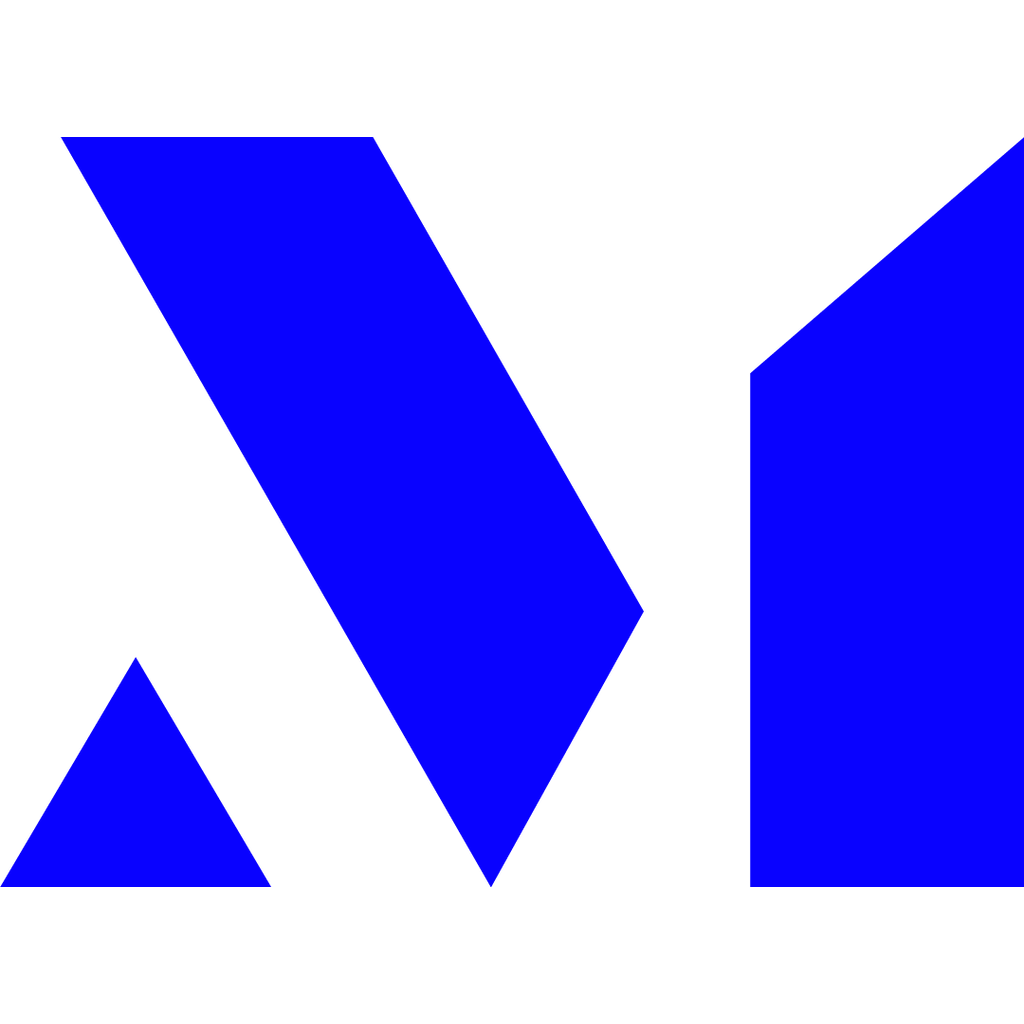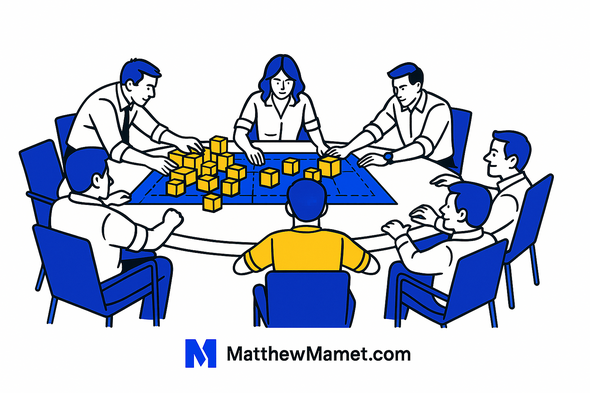Summary:
A well-designed team building workshop is a strategic investment that goes beyond superficial activities to deliver measurable benefits, particularly for software and product teams. These workshops focus on building psychological safety and reducing friction, which enhances productivity and accelerates project timelines. By addressing specific challenges like code review friction or roadmap misalignment, workshops provide concrete outcomes such as improved sprint velocity and better team alignment. The global team building market is expected to grow significantly, reflecting a shift in perception from viewing these workshops as costs to seeing them as essential investments in team effectiveness.
Table of Contents
A well-designed team building workshop is a strategic investment. It moves way beyond "fluffy" exercises to deliver tangible returns, particularly for software and product teams that live and die by their operational effectiveness.
This isn't about trust falls; it's about building psychological safety and smoothing out friction in a way that directly boosts productivity and accelerates project timelines.
The Real ROI of a Team Building Workshop
Let's get past the myth that team building is just a fun break from "real work." For fast-paced software and product teams, a structured workshop is a powerful tool with a measurable return. The focus shifts from vague hopes like "better morale" to concrete outcomes, like boosting sprint velocity, improving code reviews, and getting to consensus faster on roadmaps.
The market is catching on. The global team building service market is valued at around USD 3.2 billion as of 2025, and it's projected to surge to nearly USD 9.9 billion by 2033. That's a compound annual growth rate of about 20.16%.
Ready to drive more growth & achieve bigger impact?
Leverage my 25+ years of successes and failures to unlock your growth and achieve results you never thought possible.
Get StartedThis isn't just a trend; it's a major shift in how organizations see these workshops-not as a cost, but as an essential investment in their most valuable asset. If you're curious, you can explore more about these market trends and what they mean for building stronger teams.
From Vague Goals to Tangible Outcomes
An effective workshop is designed with specific, targeted outcomes in mind. It’s the difference between hoping for better communication and actually practicing a new framework for giving feedback on a technical design. You’re creating a controlled environment where teams can solve problems that mirror their real-world challenges.
This breakdown shows the typical time allocation for a workshop, with a heavy emphasis on application and reflection, not just talk.
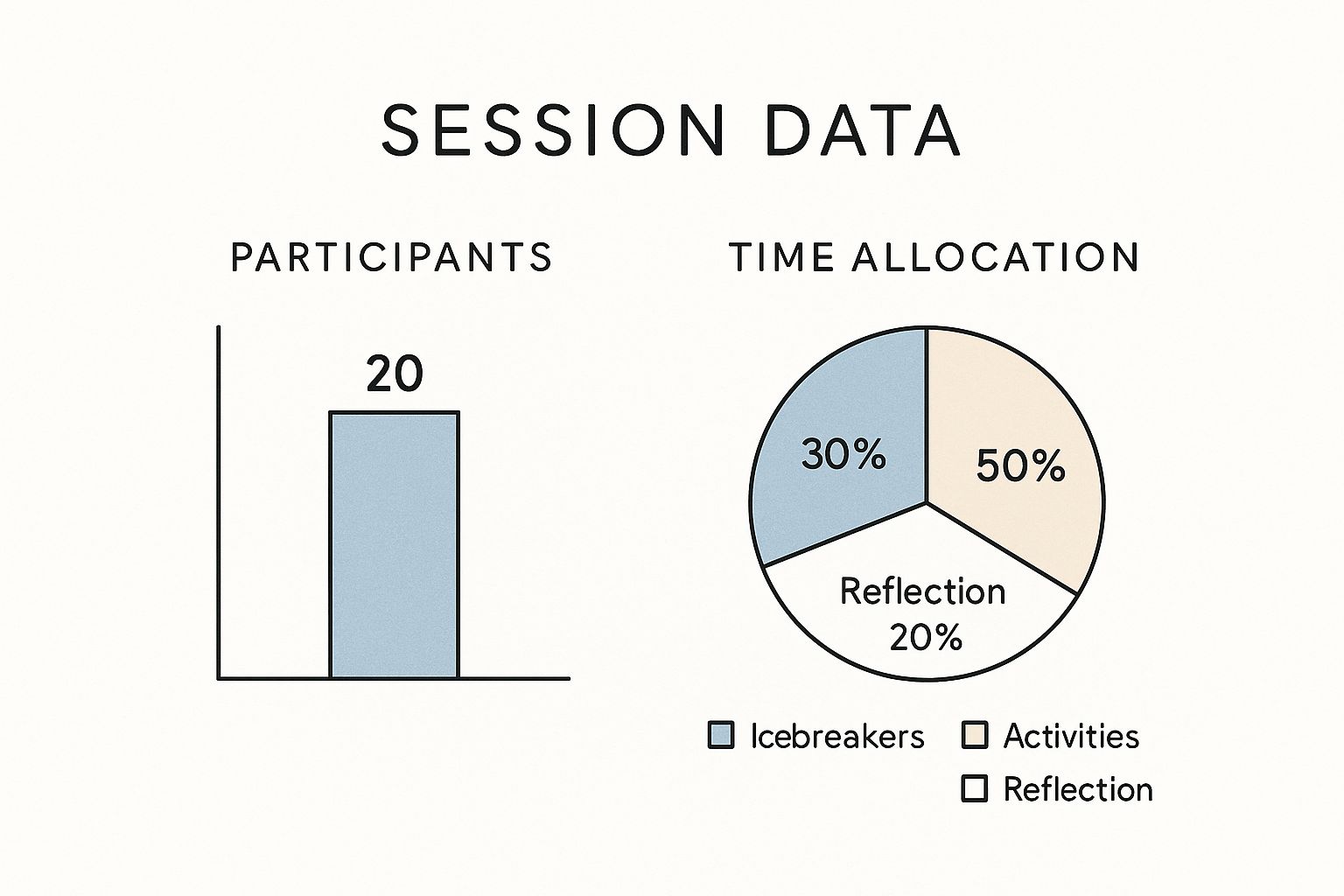
As you can see, the bulk of the session is dedicated to hands-on activities. This ensures the learning is active and immediately applicable, not just a passive lecture.
A common mistake is treating the workshop as an isolated event. Its true power is realized when the lessons, frameworks, and commitments made during the session are integrated back into daily workflows-from sprint planning to product demos.
Building Your Business Case for a Workshop
Getting the budget and buy-in for a workshop means framing it as a solution to specific business problems. Don't ask for a "team bonding day." Present it as a strategic intervention designed to fix things that are observably broken.
For software and product teams, this often means addressing common challenges head-on. A targeted workshop can be designed to tackle very specific issues that are slowing everyone down.
By connecting the workshop directly to these pain points, you transform it from a nice-to-have perk into an essential tool. It becomes a clear path to improving team performance and, ultimately, driving project success.
Setting Workshop Goals That Actually Matter
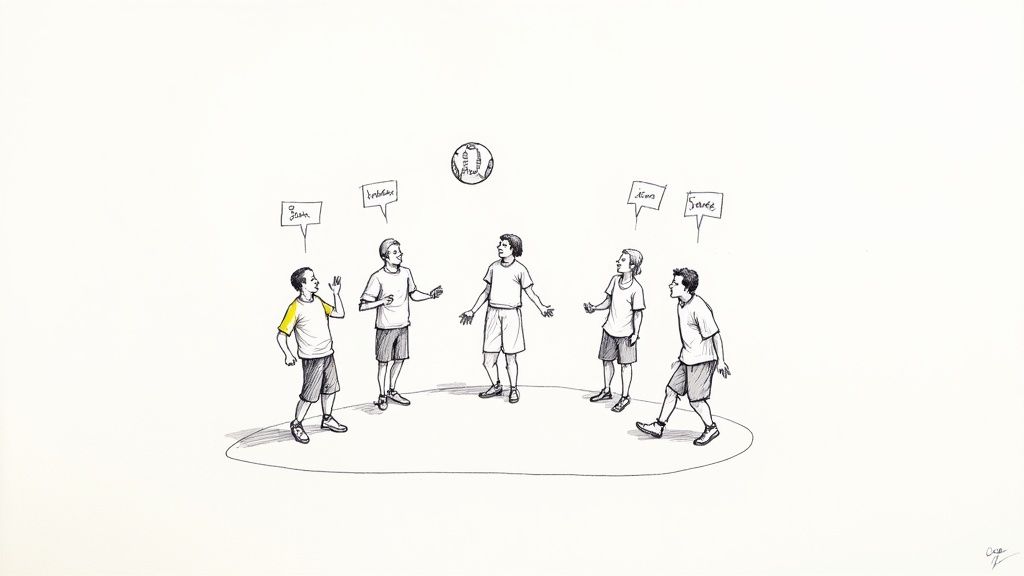
An impactful team building workshop lives or dies on one thing: having crystal-clear objectives. Vague goals like “improving communication” or “boosting morale” might sound nice, but they don't give you a roadmap for success or a benchmark for measurement. Honestly, they're the empty calories of workshop planning.
Instead, your goals have to be precise and actionable. This is what turns a generic get-together into a focused, strategic intervention. The trick is to move from broad issues to specific, observable outcomes.
Pinpoint the Real Problem
Before you can even think about goals, you have to get your hands dirty and diagnose the core issue holding your team back. Is that friction you’re seeing a symptom of a broken process, a communication breakdown, or something deeper, like a trust deficit? Getting this diagnosis right is everything.
Ready to drive more growth & achieve bigger impact?
Leverage my 25+ years of successes and failures to unlock your growth and achieve results you never thought possible.
Get StartedI’ve seen these scenarios play out on software and product teams over and over:
- Symptom: Sprint commitments are constantly missed, creating a rift between engineering and product.
- Symptom: Code reviews devolve into personal arguments, grinding the development cycle to a halt.
- Symptom: Junior developers are silent during planning meetings, which means major risks get overlooked.
Each of these points to a different root cause. Missed commitments might be about poor estimation, while combative code reviews could signal a lack of psychological safety. Your workshop needs to address the cause, not just the symptom.
The most successful workshops are less about team "building" and more about team "fixing." They identify a specific, high-friction point in the team’s workflow and dedicate focused energy to resolving it. This approach guarantees relevance and immediate value.
Translate Problems into Actionable Goals
Once you’ve got a handle on the real problem, you can frame a goal that is both specific and measurable. This is where you connect the problem to a real, tangible workshop outcome. A strong goal gives your session a clear “finish line.”
Let's take our earlier scenarios and turn them into powerful workshop objectives.
| From Vague Problem To... | ...Specific, Actionable Goal |
|---|---|
| "Our sprints are always behind." | "Co-create a new sprint planning checklist that accounts for cross-team dependencies and refactoring time." |
| "Code reviews are toxic." | "Establish a team-wide protocol for giving and receiving technical feedback that separates critique of the code from critique of the coder." |
| "Junior devs don't speak up." | "Develop a 'pre-mortem' facilitation technique that empowers all team members to voice concerns about a project plan before it's finalized." |
This level of specificity does two critical things. First, it forces you to design activities that directly serve the goal. Second, it gives the team a clear, shared purpose for their time. The activities are no longer just games; they’re focused tools for solving a real problem. This precision ensures every part of the team building workshop is built for your team's most urgent needs.
Align Goals with Broader Team Culture
Ultimately, these targeted goals should ladder up to the bigger objective: creating a healthier, more effective work environment. A workshop can be a powerful catalyst, but the changes have to be woven into the team's daily fabric to stick.
Ready to drive more growth & achieve bigger impact?
Leverage my 25+ years of successes and failures to unlock your growth and achieve results you never thought possible.
Get StartedFor those looking to zoom out, understanding how to improve team culture is the logical next step. A well-designed workshop can be the perfect kickoff for these larger improvements. By fixing one specific interaction, you build the trust and momentum needed to tackle bigger challenges down the road. It makes the workshop not an end in itself, but a vital beginning.
Designing an Agenda for Analytical Minds
This is where the rubber meets the road. You've got the vision for your team building workshop, but now you have to translate that into a concrete plan. Crafting the right agenda is an art form, especially when your audience is a room full of engineers, product managers, and other analytical thinkers who live and breathe logic and efficiency.
Let's be honest: a poorly structured agenda packed with fluffy, pointless activities will lose them before you even get started. They'll see right through it. The trick is to design a day that flows logically, respects their time, and connects every single activity back to a real-world work challenge. Think of the agenda less like a list of games and more like a structured, facilitated problem-solving session.

Moving Beyond Generic Icebreakers
First things first: forget asking everyone their favorite animal. Most analytical teams find traditional icebreakers cringey and a complete waste of time. Your real goal isn't just to "warm up the room," but to do it with an activity that’s both engaging and directly relevant to the day's objectives.
Instead of a generic get-to-know-you game, try a "soft opening" that immediately frames the workshop in a problem-solving context they can appreciate.
Ready to drive more growth & achieve bigger impact?
Leverage my 25+ years of successes and failures to unlock your growth and achieve results you never thought possible.
Get Started- The One-Word Goal: Ask everyone to write down a single word describing what they hope the team achieves in the next quarter. Go around the room and have each person share their word and one sentence explaining it. This is a fast way to get everyone aligned on shared goals.
- Passion Tic-Tac-Toe: Give everyone a 3x3 grid to fill with personal passions (e.g., "brewing kombucha," "optimizing CI/CD pipelines," "3D printing"). They then have to mingle and find others who share those passions, getting signatures to complete a row. It’s a structured, almost game-like way to find common ground beyond job titles.
These approaches work because they replace abstract social exercises with focused, purposeful interactions. You're building rapport while getting right down to business.
The most effective agenda for a technical team feels less like a party and more like a well-designed experiment. It has a clear hypothesis (our goal), a structured methodology (the activities), and a defined process for analyzing the results (the debriefs).
Curated Activities for Technical Teams
The heart of your workshop should be built around simulations that mirror the team's actual, day-to-day challenges. This is what makes the exercises feel practical, not theoretical. When engineers and PMs see a direct link between an activity and a problem they face every day, they get invested. Deeply.
You want activities that let them flex their natural problem-solving muscles, just in a new context.
- Process "Bug Bash": I love this one. Frame a broken internal process-like the handoff between design and engineering-as a piece of buggy software. The team's mission is to work together to find the "bugs" (the bottlenecks and frustrations), document them, and then "patch" the process with a new, co-created workflow.
- Role-Playing Difficult Conversations: Set up a realistic scenario. A team member has to give critical feedback on a flawed technical design or a vague product requirement. This isn't about winning an Oscar; it’s a simulation to practice de-personalizing feedback and keeping the focus on the work itself.
- The Silent Planning Game: To tackle alignment issues, have the team build a project timeline or feature roadmap using only sticky notes on a whiteboard. No talking allowed. This forces them to rely on visual communication and consensus, and it instantly highlights where assumptions and misinterpretations are happening.
These exercises are mentally stimulating and directly applicable, which is absolutely critical for keeping analytical minds bought-in for an entire team building workshop.
Balancing Energy and Reflection
A classic mistake is packing the agenda with back-to-back, high-energy activities. This is a surefire way to cause exhaustion and burnout, especially for the more introverted folks on your team.
The best agendas I've ever run alternate between intense, collaborative work and periods of quiet, individual reflection. This rhythm gives ideas time to marinate and ensures insights from one activity aren't lost in the rush to the next.
Ready to drive more growth & achieve bigger impact?
Leverage my 25+ years of successes and failures to unlock your growth and achieve results you never thought possible.
Get StartedA structured debrief after every single exercise is non-negotiable. This is where the real learning happens and gets tied back to the team's daily reality.
Here’s a sample flow that shows this balance in action:
| Time | Activity | Purpose |
|---|---|---|
| 9:00 AM | Workshop Kickoff & One-Word Goal | Align on objectives and set a focused tone. |
| 9:30 AM | Activity 1: Process "Bug Bash" | High-energy, collaborative problem-solving. |
| 10:45 AM | Structured Debrief & Individual Reflection | Quiet time to process insights and document personal takeaways. |
| 11:15 AM | Activity 2: Role-Playing Feedback Scenarios | Focused practice on a specific communication skill. |
| 12:30 PM | Lunch Break | Unstructured downtime to recharge and connect informally. |
| 1:30 PM | Group Discussion: Synthesizing Morning Lessons | Connect learnings from both activities to spot overarching themes. |
| 2:30 PM | Action Planning: Co-creating a Team Charter | Translate insights into concrete, actionable commitments. |
| 3:45 PM | Closing & Next Steps | Solidify commitments and define how progress will be measured. |
This kind of structure ensures the workshop isn't just a series of disconnected events. It becomes a cumulative experience where each part builds on the last, guiding the team toward a genuinely useful outcome.
Facilitating a Truly Engaging Session
A brilliant agenda is just the starting point. The real magic-or failure-happens in the room, during the session itself. Facilitating a genuinely engaging workshop is an art, especially when you’re dealing with the mix of personalities you find on any software or product team.
Your job as the facilitator is to create and fiercely protect a space where every single person feels safe enough to contribute their best thinking. That means everyone from the most outspoken product lead to the most introverted senior engineer. You’re not just a guide; you’re the guardian of the team's psychological safety, managing the room's energy, navigating the inevitable disagreements, and keeping the vibe positive and constructive.
Reading the Room and Managing Personalities
Great facilitation is all about adaptability. You can't just plow through your agenda if an activity is falling flat or the energy in the room has tanked. You have to be ready to pivot. Always have a few backup exercises or discussion prompts in your back pocket. Sometimes you need to swap a high-energy game for a quiet, reflective exercise to give the team a moment to breathe and process.
Managing personalities is just as crucial. You'll likely need to:
- Gently interrupt the voices that tend to dominate. Try something like, "That's a great point, Alex. I'd love to hear what someone from the QA team thinks about that." It creates an opening without shutting anyone down.
- Directly invite quieter folks to share their thoughts, but without putting them on the spot. For instance, "Maria, you have a ton of experience with this part of the codebase. Does this idea seem feasible to you?"
- Reframe conflict as healthy debate. When things get tense, your role is to steer the conversation back to the problem, not the people. Focus on objective facts and the goals you all share.
When you're trying to bridge different communication styles, exploring various collaborative learning examples can give you fresh ideas for activities that resonate with everyone. Your goal is to ensure that even when there's friction, it’s productive, not destructive. Understanding these dynamics is core to the continuous journey of building and sustaining high-performing teams. You can learn more by exploring our detailed guide on how to build high-performing teams.
The Art of the Debrief
This is the most important part. The single most critical element of any team building workshop is the debrief that comes after an activity. This is where you turn a shared experience into real, actionable learning. Without a powerful debrief, even the most fun activity is just a game-a missed opportunity.
Ready to drive more growth & achieve bigger impact?
Leverage my 25+ years of successes and failures to unlock your growth and achieve results you never thought possible.
Get StartedResearch consistently backs this up. One study on a two-day team building workshop showed that targeted activities paired with structured debriefs led to a 30% increase in collaborative problem-solving. It’s solid proof that the post-activity discussion is where the real value gets unlocked.
So, instead of asking lazy questions like, "How did that feel?", you need to use specific, powerful prompts that force the team to connect the dots back to their daily work.
A great debrief doesn't ask what happened in the activity; it asks how the activity reflects what happens at work. The goal is to create a mirror that helps the team see its own behaviors and patterns more clearly.
Here are a few questions I’ve found to be incredibly effective:
- What specific behavior in that activity helped us succeed, and where do we already see that same behavior in our daily stand-ups?
- Where did we get stuck in that exercise? Does that feel similar to any recurring bottlenecks we hit in our sprint planning?
- Based on what we just experienced, what is one small change we can all commit to making in how we handle code reviews next week?
These kinds of questions make the learning concrete. They push the team to move beyond a fleeting insight from the workshop and toward a tangible, agreed-upon behavioral change they can implement on Monday morning. That's how you make it stick.
How to Measure and Sustain Workshop Impact
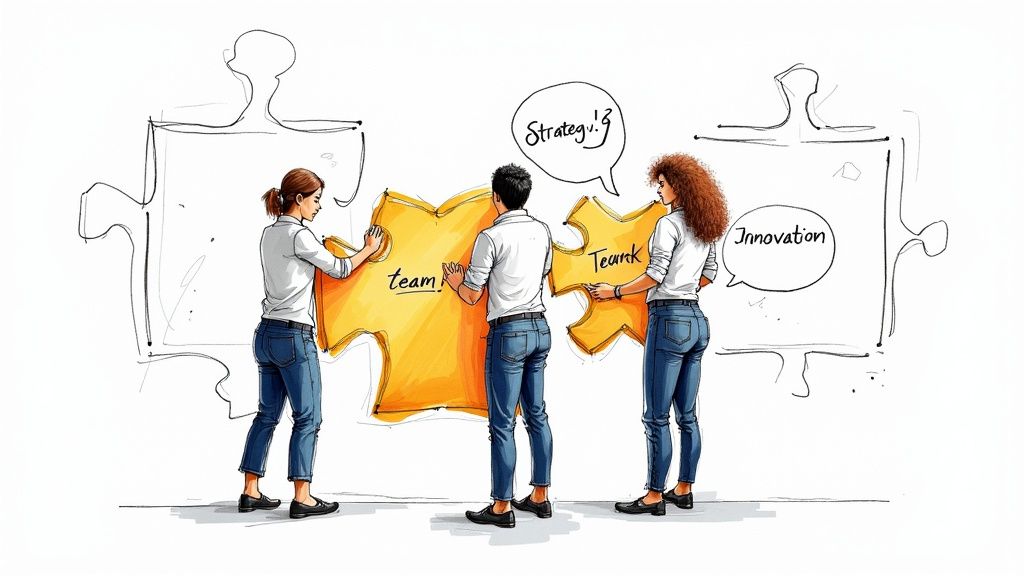
The positive energy after a great team building workshop is palpable. But how do you prove it was more than just a fun day away from the usual grind?
The real test is whether the insights and new behaviors stick around. Measuring the impact and embedding those lessons into your team’s DNA is what separates a forgettable event from a true strategic investment. Your goal is to translate that workshop momentum into sustainable, observable changes in how the team operates day-to-day.
Without this crucial follow-through, you risk losing all the value you just created.
Move Beyond Generic Surveys
The standard post-workshop survey-riddled with "rate from 1-10" questions-is a huge missed opportunity. While it can gauge immediate satisfaction, it rarely captures meaningful shifts in team dynamics. To get real data, your feedback mechanism needs to be as thoughtful as the workshop itself.
Ready to drive more growth & achieve bigger impact?
Leverage my 25+ years of successes and failures to unlock your growth and achieve results you never thought possible.
Get StartedInstead of asking generic questions, focus on capturing specific behavioral intentions and observations.
- Ask about specifics: "What is one new approach from today's session that you will apply in our next sprint planning meeting?"
- Prompt for observation: "Describe a moment during the workshop where you saw the team communicate more effectively than usual."
- Focus on commitment: "What is one thing you will personally do differently in code reviews starting next week?"
These kinds of questions push participants beyond a simple satisfaction score. They get people reflecting and committing, providing you with qualitative data that speaks directly to the workshop's goals.
Track Observable Behavioral Metrics
The most powerful proof of a workshop's success isn't found in a survey; it's seen in the team's daily workflow. Before the workshop, identify a few key performance indicators (KPIs) tied to the problems you want to solve. Then, track them closely afterward.
This isn't as complicated as it sounds. You’re simply looking for real-world evidence of change.
Examples of Pre- and Post-Workshop Metrics
| Metric Category | Before Workshop | After Workshop Goal |
|---|---|---|
| Code Review Quality | Comments are often terse, critical, or trigger long debates. | Pull request comments become more constructive, using phrases like "Have you considered..." |
| Meeting Efficiency | Daily stand-ups regularly run over 20 minutes with side conversations. | Stand-ups are consistently under 15 minutes, with blockers clearly identified. |
| Management Escalations | Team members frequently escalate interpersonal or minor technical disputes to a manager. | The team resolves more conflicts peer-to-peer, leading to a 20% reduction in escalations. |
| Decision-Making Speed | Product feature decisions get stuck in cycles of debate for days. | The team uses a new decision-making framework to reach consensus within a single meeting. |
These metrics provide hard evidence that the workshop delivered tangible value. It also shows the team that the changes are being taken seriously, which reinforces the new behaviors.
Solidify Learnings with a Team Charter
One of the best ways I've found to sustain momentum is to create a living document that captures the team's new commitments. This tangible output, often called a Team Charter or Ways of Working Agreement, transforms abstract insights into a concrete social contract.
This document should be co-created by the team, ideally as the final activity of the workshop. It outlines their shared agreements on crucial interaction points.
A Team Charter is not a set of rules imposed by management. It’s a peer-to-peer commitment owned by the team. It’s their collective answer to the question: "How do we agree to behave when things get tough?"
This charter can be a powerful tool for self-correction. When a team member notices a deviation from an agreed-upon norm, they can point back to the charter, making the feedback objective rather than personal. This process is essential, as data shows that a lack of effective teamwork is a major driver of inefficiency.
Ready to drive more growth & achieve bigger impact?
Leverage my 25+ years of successes and failures to unlock your growth and achieve results you never thought possible.
Get StartedRecent studies show that 86% of employees and managers cite poor communication and collaboration as a primary cause of workplace issues. But organizations that actively work on this can see productivity jump by around 25%. You can read more teamwork statistics on ElectroIQ.com.
Sustaining impact also involves integrating these new practices with your existing systems. For those looking to take the next step, you might be interested in boosting team efficiency with automation tools, which can help codify some of the new processes agreed upon in the workshop.
Of course. Here is the rewritten section, following the style and tone of the provided examples.
Common Questions About Team Building Workshops
Even with the best-laid plans, questions are going to pop up. This is especially true when you're the one trying to justify the time and expense of pulling a whole team away from their work for a day.
Let's tackle some of the most common ones I hear from managers.
What’s a Realistic Budget for a Good Workshop?
This is the million-dollar question, isn't it? The honest answer is: it depends. You could spend almost nothing on a DIY session in a conference room, or you could invest thousands in a full-day offsite with a professional facilitator.
But that’s not a very helpful answer. A much better way to think about it is to frame the cost against the cost of inaction.
If communication breakdowns are delaying a product launch by two weeks, what’s the real business impact of that slip? Suddenly, a $5,000 workshop that unblocks your team doesn't seem like an expense; it looks like a bargain.
Ready to drive more growth & achieve bigger impact?
Leverage my 25+ years of successes and failures to unlock your growth and achieve results you never thought possible.
Get StartedFor a professionally run, full-day workshop for a team of 15, you can expect to invest anywhere from $3,000 to $10,000. That range covers the facilitator's experience, the venue, and any materials. A half-day session might run you $1,500 to $5,000.
The key is to stop thinking about the workshop as a cost and start seeing it as an investment in your team's operating system. When you pitch this to leadership, don't just present a budget. Present a solution to a real business problem with a clear return.
How Long Should a Workshop Be?
The right length depends entirely on what you're trying to accomplish. Trying to cram too much into a couple of hours is a recipe for a superficial session where nothing really sticks. But a workshop that drags on too long will lose everyone’s energy and focus.
Here’s a practical breakdown based on my experience:
- Half-Day (3-4 hours): This is perfect for a single, focused objective. Think things like co-creating a new code review process or running a specific problem-solving simulation. It's just long enough to get something meaningful done while keeping energy high.
- Full-Day (6-8 hours): Go for a full day when you need to tackle more complex or tangled issues. This is for things like a lack of psychological safety or deep-seated friction between product and engineering. It gives you the space for deeper dives, multiple activities, and real action planning.
- Two Days: Save this for the big stuff-major team resets, leadership offsites, or annual strategic planning. This format allows for the deep relationship-building and comprehensive strategy work that you just can't rush.
Remember, a shorter, more focused workshop is always better than a long, rambling one. Respect your team's time, and they'll give you their full attention.
What if Some Team Members Are Skeptical?
You will always have skeptics. It's a given. Engineers, in particular, are trained to be critical thinkers and can sniff out "fluffy" corporate HR exercises from a mile away.
Ignoring their skepticism is the worst thing you can do. You have to meet it head-on.
The best way to do this is with transparency and by framing the day in a way that appeals to their logical, problem-solving mindset.
- Acknowledge the Elephant in the Room: Kick things off by saying something like, "I know some of you might be thinking this is just another rah-rah team building day. I want to assure you it’s not. We’re here to solve a real problem."
- Focus on the Problem, Not "Bonding": Engineers want to fix things that are broken. Frame the workshop as a structured session to fix a tangible pain point-a clunky deployment process, ambiguous requirements, or inefficient meetings.
- Get Their Buy-In: Ask a senior, respected (and maybe even skeptical) engineer to help you vet the agenda beforehand. Getting their input doesn't just improve the plan; it can turn a vocal critic into your strongest advocate.
When your skeptics see the workshop is grounded in logic and aimed at making their work life better, they’ll come around. You're not asking them to hold hands and sing "Kumbaya." You're asking them to help you de-bug a broken team process. That’s a language they understand and respect.
Ready to move beyond questions and start building a high-performing team? At Matthew Mamet, I provide specialized coaching and strategic guidance to help software executives and product leaders cultivate exceptional team cultures and drive measurable results. Schedule a consultation with me today to design a leadership strategy that unlocks your team’s full potential.
Ready to drive more growth & achieve bigger impact?
Leverage my 25+ years of successes and failures to unlock your growth and achieve results you never thought possible.
Get Started